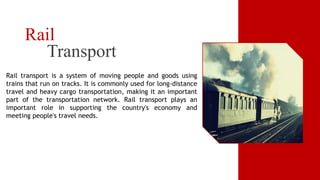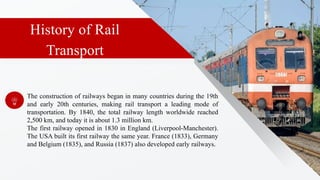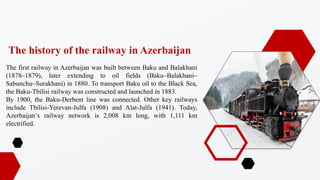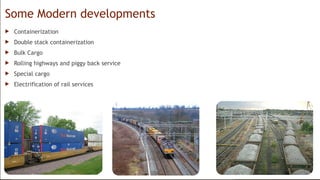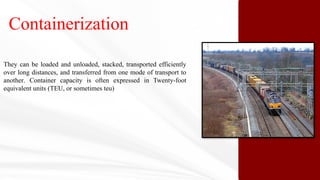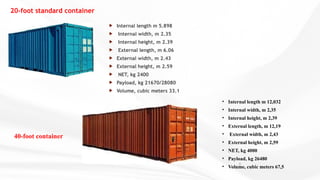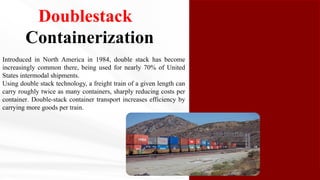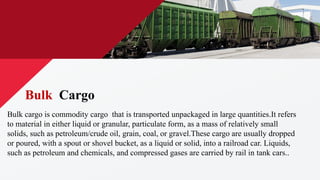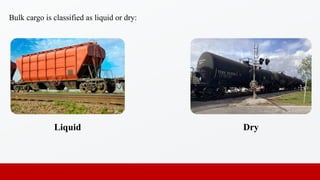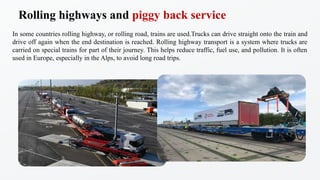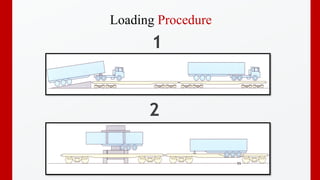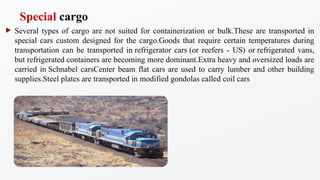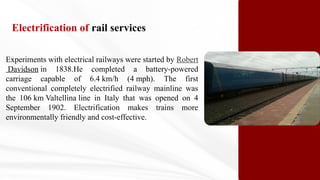Rail transport and some modern devolopments in rail transport 2025.pptx
- 1. Transport Rail Rail transport is a system of moving people and goods using trains that run on tracks. It is commonly used for long-distance travel and heavy cargo transportation, making it an important part of the transportation network. Rail transport plays an important role in supporting the country's economy and meeting people's travel needs.
- 2. History of Rail Transport The construction of railways began in many countries during the 19th and early 20th centuries, making rail transport a leading mode of transportation. By 1840, the total railway length worldwide reached 2,500 km, and today it is about 1.3 million km. The first railway opened in 1830 in England (Liverpool-Manchester). The USA built its first railway the same year. France (1833), Germany and Belgium (1835), and Russia (1837) also developed early railways.
- 3. The first railway in Azerbaijan was built between Baku and Balakhani (1878¨C1879), later extending to oil fields (Baku¨CBalakhani¨C Sabunchu¨CSurakhani) in 1880. To transport Baku oil to the Black Sea, the Baku-Tbilisi railway was constructed and launched in 1883. By 1900, the Baku-Derbent line was connected. Other key railways include Tbilisi-Yerevan-Julfa (1908) and Alat-Julfa (1941). Today, AzerbaijanˇŻs railway network is 2,008 km long, with 1,111 km electrified. The history of the railway in Azerbaijan
- 4. Some Modern developments ? Containerization ? Double stack containerization ? Bulk Cargo ? Rolling highways and piggy back service ? Special cargo ? Electrification of rail services
- 5. Containerization They can be loaded and unloaded, stacked, transported efficiently over long distances, and transferred from one mode of transport to another. Container capacity is often expressed in Twenty-foot equivalent units (TEU, or sometimes teu)
- 6. 20-foot standard container ? Internal length m 5.898 ? Internal width, m 2.35 ? Internal height, m ? ? 2.39 ? External length, m 6.06 ? External width, m 2.43 ? External height, m ? ? 2.59 ? NET, kg 2400 ? Payload, kg 21670/28080 ? Volume, cubic meters 33.1 6 ? Internal length m 12,032 ? Internal width, m 2,35 ? Internal height, m ? ? 2,39 ? External length, m 12,19 ? External width, m 2,43 ? External height, m ? ? 2,59 ? NET, kg 4000 ? Payload, kg 26480 ? Volume, cubic meters 67,5 40-foot container
- 7. Doublestack Containerization Introduced in North America in 1984, double stack has become increasingly common there, being used for nearly 70% of United States intermodal shipments. Using double stack technology, a freight train of a given length can carry roughly twice as many containers, sharply reducing costs per container. Double-stack container transport increases efficiency by carrying more goods per train.
- 8. Bulk cargo is commodity cargo that is transported unpackaged in large quantities.It refers to material in either liquid or granular, particulate form, as a mass of relatively small solids, such as petroleum/crude oil, grain, coal, or gravel.These cargo are usually dropped or poured, with a spout or shovel bucket, as a liquid or solid, into a railroad car. Liquids, such as petroleum and chemicals, and compressed gases are carried by rail in tank cars.. Bulk Cargo
- 9. Bulk cargo is classified as liquid or dry: Liquid Dry
- 10. In some countries rolling highway, or rolling road, trains are used.Trucks can drive straight onto the train and drive off again when the end destination is reached. Rolling highway transport is a system where trucks are carried on special trains for part of their journey. This helps reduce traffic, fuel use, and pollution. It is often used in Europe, especially in the Alps, to avoid long road trips. Rolling highways and piggy back service
- 12. ? Several types of cargo are not suited for containerization or bulk.These are transported in special cars custom designed for the cargo.Goods that require certain temperatures during transportation can be transported in refrigerator cars (or reefers - US) or refrigerated vans, but refrigerated containers are becoming more dominant.Extra heavy and oversized loads are carried in Schnabel carsCenter beam flat cars are used to carry lumber and other building supplies.Steel plates are transported in modified gondolas called coil cars Special cargo
- 13. Experiments with electrical railways were started by Robert Davidson in 1838.He completed a battery-powered carriage capable of 6.4 km/h (4 mph). The first conventional completely electrified railway mainline was the 106 km Valtellina line in Italy that was opened on 4 September 1902. Electrification makes trains more environmentally friendly and cost-effective. Electrification of rail services
